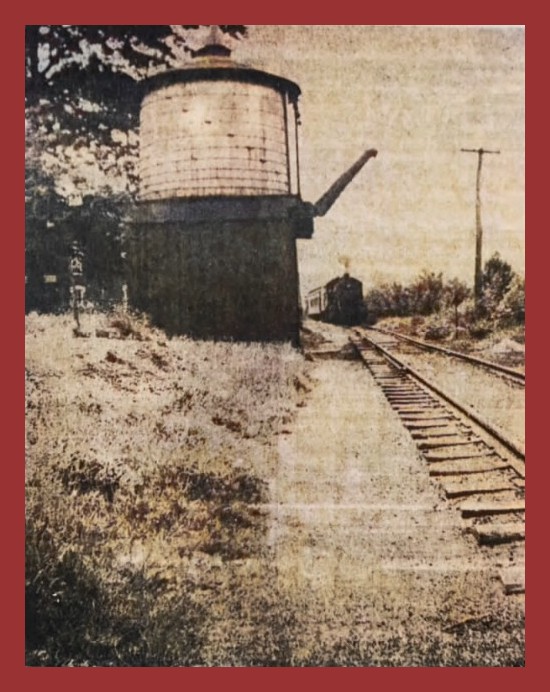
In his July 28, 1966, column in the Lykens Standard, “Lykens of Yesteryear,” C. L. Peters reflected on the earlier railroads of the Lykens Valley area. The photo accompanying the article was of the water tower west of Lykens; it shows a passenger train pulled by a steam locomotive. Peters also spends time telling of the Midland Pennsylvania Railroad, of which many posts are photos are available on this blog.
IRON HORSE
A new television series entitled “Iron Horse,” will soon be seen weekly on your home screen. This story is reminiscent of the part the early trains played with the settling of the West.
Although joining of two sections of railroad in our local area was not marked by use of a golden spike, as was used in the western episode, the spikes used in our early railroads spiked the flow of gold, black gold that is, between Wiconisco and Millersburg. In the western episodes as in the “Pettycoat Junction” series, the old water tanks that provided the engines with water for making steam are a prominent and necessary prop for the railroad settings.
Many of you remember the old water tank across from the Lykens Standard office, but how many of you remember the one south of the Lawley Road, west of Lykens?
On the Reading Railroad there was a tank at the junction North and Spruce Streets. These tanks were made of wood and occasionally sprang a leak, causing delays in watering the boilers.
These were landmarks, long since removed with the advent of the diesel engines. There was almost a water tank located in the vicinity of Gratz. Almost. It so happened that Simon Gratz, the founder of the Borough of Gratz, had many wealthy and influential friends in Philadelphia. Simon himself was endowed with a good share of worldly goods. In fact he helped plan and was one of the original stock holders of the Lykens Valley Railroad & Coal Company. Simon Gratz died in 1839, but the second locomotive to be used on this line was named in his honor. Although Simon died long before the turn of the century, his son Edward Gratz, took up residence on the south side of Short Mountain and in 1848 laid out the town of Lykens. Edward Gratz died in 1869, but left a son, David Gratz, father of Jacob Gratz and Edward Gratz, still living in Lykens [in 1966]. While David Gratz still lived several old family friends visited with him and paid homage to the elder Simon Gratz and Theodore Gratz in the Borough carrying their name. They were enthused and overwhelmed by the beauty of the specious Lykens Valley, but were equally surprised that the valley should be without any means of transportation, except horse and wagon, for marketing their produce. They saw an opportunity and resolved to form a company for the purpose of building a railroad between Millersburg on the west and Ashland on the east. Plans went forth, stock was sold, land procured, and ground was broken and work started late in the year 1910. It was to be called the Midland Pennsylvania Railroad. During the year 1911 things were really humming, and grading, filling and preparations were in evidence all of the 44 miles from Millersburg to Ashland. Bit it was an ill-fated project from the date of its very inception. It proved to be more expensive to move in equipment and supplies than originally anticipated, and late in 1911 the available money was expended and grading east of Millersburg was still incomplete.
It then became necessary to secure funds from New York. Then the second setback occurred. In 1913, Mr. Finley Acker, one of the vice presidents, whose whole heart was in the project, died. Things were quiet during 1914 and 1915, but another attempt was made in 1916. The company was re-organized and seventy men were employed at grading and laying track. By November of that year excursions were actually run between Millersburg and a point near Berrysburg, and grain, coal, timber and other commodities were transported between these two points. Then came another shortage of funds and during this clash over finances World War I was entered by the Government, and this was the final blow. All work ceased and after the war it appeared that all interest was lost. A New York firm acquired the franchise and all the work and labor of love were lost. The tracks were removed and everything salvaged.
At many places along the route the graded areas are still noticeable.
The water tank near Gratz was never erected and the Midland railroad is only a memory.
____________________________________________________
Article and photo from Newspapers.com.
Corrections and additional information should be added as comments to this post.